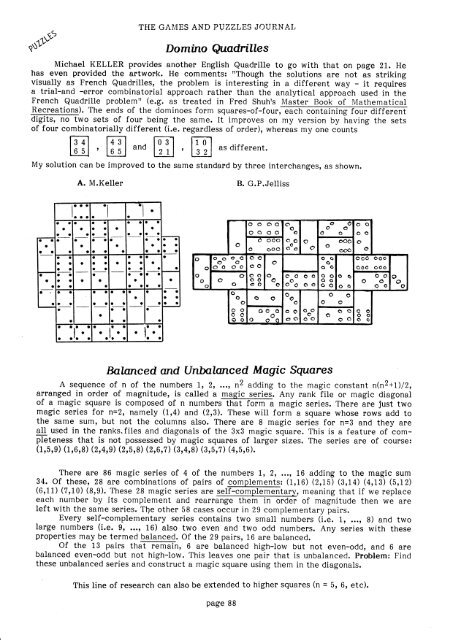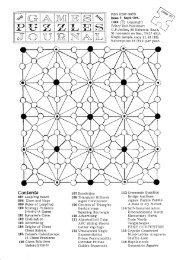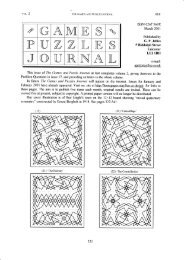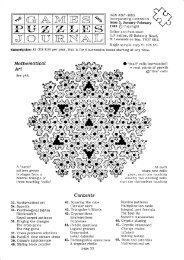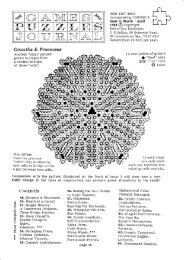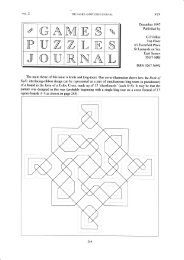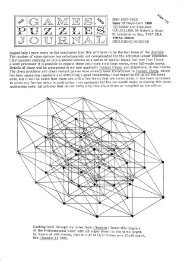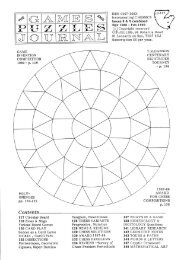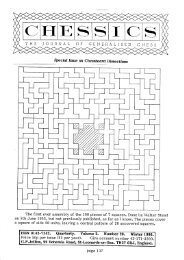The Games and Puzzles Journal, #5+6 - Mayhematics
The Games and Puzzles Journal, #5+6 - Mayhematics
The Games and Puzzles Journal, #5+6 - Mayhematics
Create successful ePaper yourself
Turn your PDF publications into a flip-book with our unique Google optimized e-Paper software.
THE GAT/IES AND PUZ.ZI,ES JOURNAI,<br />
'd<br />
Domino Quodrtlles<br />
Michael KELLER provides another English Quadrille to go with that on page 21. He<br />
has even provided the artwork. He eomments: ttThough the solutions are not as striking<br />
visually as French Quadrilles, the problem is interesting in a different way - it requires<br />
a trial-<strong>and</strong> -error combinatorial approach rather than the anatytical approach used in the<br />
French Quadrille problem'r (e.g. as treated in Fred Shuhts Master Book of Mathematical<br />
Recreations).<strong>The</strong>endsofthedominoesformsquares.of-four,<br />
aigiTs' lloTwo sets of four being the same. It improves on my version by Laving the sets<br />
of four combinatorially different (i.e. regardless of order), whereas my one counts<br />
m'H <strong>and</strong> H ,H asdirrerent'<br />
My solution can be improved to the same st<strong>and</strong>ard by three interchanges, as shown.<br />
o<br />
a<br />
;-:<br />
oa o<br />
a o<br />
oo<br />
;_- a<br />
o<br />
o<br />
.O<br />
ao<br />
ao<br />
OO<br />
of<br />
I t<br />
ao<br />
oa<br />
oa<br />
lo<br />
oo<br />
oa<br />
a<br />
ot<br />
o<br />
a oo<br />
t<br />
A. M.Keller B. G.P.Jelliss<br />
ao<br />
o al. a | ,l a<br />
o .l.<br />
t o<br />
o<br />
ao<br />
t<br />
ot<br />
.i O<br />
o<br />
o<br />
o to<br />
oa I<br />
oo o<br />
oo o<br />
a,. a-<br />
o<br />
o<br />
oo OO<br />
oa<br />
?-J oo<br />
o l.<br />
r f r a<br />
o<br />
o<br />
o o o<br />
oooo<br />
oo<br />
o o oo<br />
fulorrtced <strong>and</strong> Unbalwtced Magi.c Sqrares<br />
A sequence of n of the numbers L, 2, ..., n2 adding to the magic constant n(n2+I)/2,<br />
arranged in order of magnitude, is called a magic series. Any rank file or magic diagonal<br />
of a magic square is composed of n numbers-ThaT-Iorrn a magic series. <strong>The</strong>re are just two<br />
magic series for n=2, namely (1,4) <strong>and</strong> (2,3). <strong>The</strong>se will form a square whose rows add to<br />
the same sum, but not the columns also. <strong>The</strong>re are 8 magic series for n=3 <strong>and</strong> they are<br />
all used in the ranks. files <strong>and</strong> diagonals of the 3x3 magic square. This is a feature of com-<br />
[IEteness that is not possessed by magic squares of laiger iizes. <strong>The</strong> series are of course:<br />
(1,5,9) (1,6,8) (2,4,9) (2,5,8) (2,6,7) (3,e,9) (3,5,?) (4,5,6).<br />
<strong>The</strong>re are 86 magic series of 4 of the numbels 1, 2,..., 16 adding to the magic sum<br />
q4. Of these, 28 are combinations of pairs of complements: (1,16) (2,15) (3,14) (4,13) (5,12)<br />
(6'11) (?,10) (8,9). <strong>The</strong>se 28 magic series are selTrcomplenrentary, meaning that if we replace<br />
each number by its complement <strong>and</strong> rearrange them in order of magnitude then we are<br />
left with the same series. Tfe other 58 cases occur in 29 complementary pairs.<br />
Every self-complementary series contains two small numbers (i.e. 1, ..., 8) <strong>and</strong> two<br />
large numbers (i.e. 9, ..., 16) also two even <strong>and</strong> two odd numbers. Any series with these<br />
properties may be termed balanced. Of the 29 pairs, 16 are balanced.<br />
of the 13 pairs tnat iffin, 6 are balanced high-low but not even-odd, <strong>and</strong> 6 are<br />
balanced even-odd but not high-low. This leaves one pair that is unbalanced. Problem: Find<br />
these unbalanced series <strong>and</strong> construct a magic square using them in the diagonals.<br />
ooo<br />
ooo<br />
o<br />
oo<br />
oo<br />
o<br />
Oo<br />
oo<br />
o<br />
oo<br />
oo<br />
oo<br />
oo<br />
This line of research can also be extended to higher squares (n = 5, 6, etc).<br />
page 88<br />
oooo<br />
ooo oo<br />
oOO ooo<br />
ooo ooo


